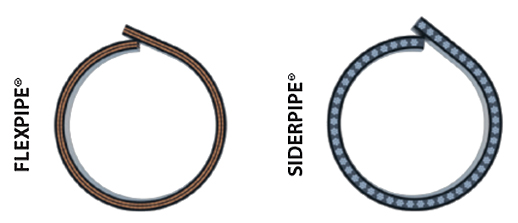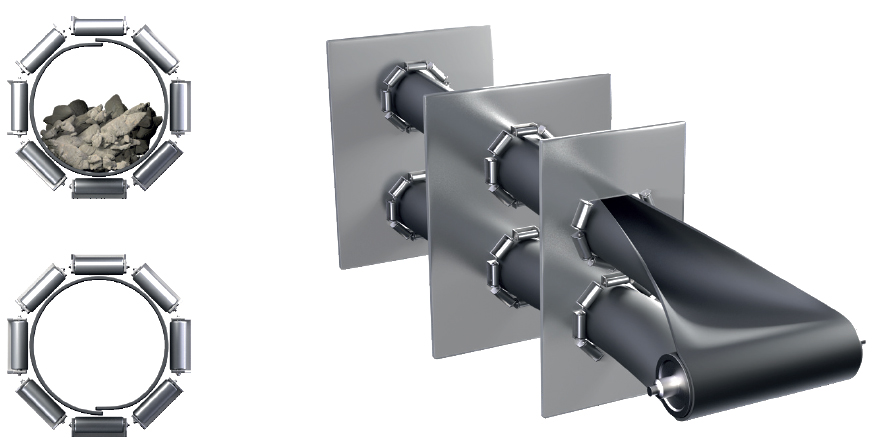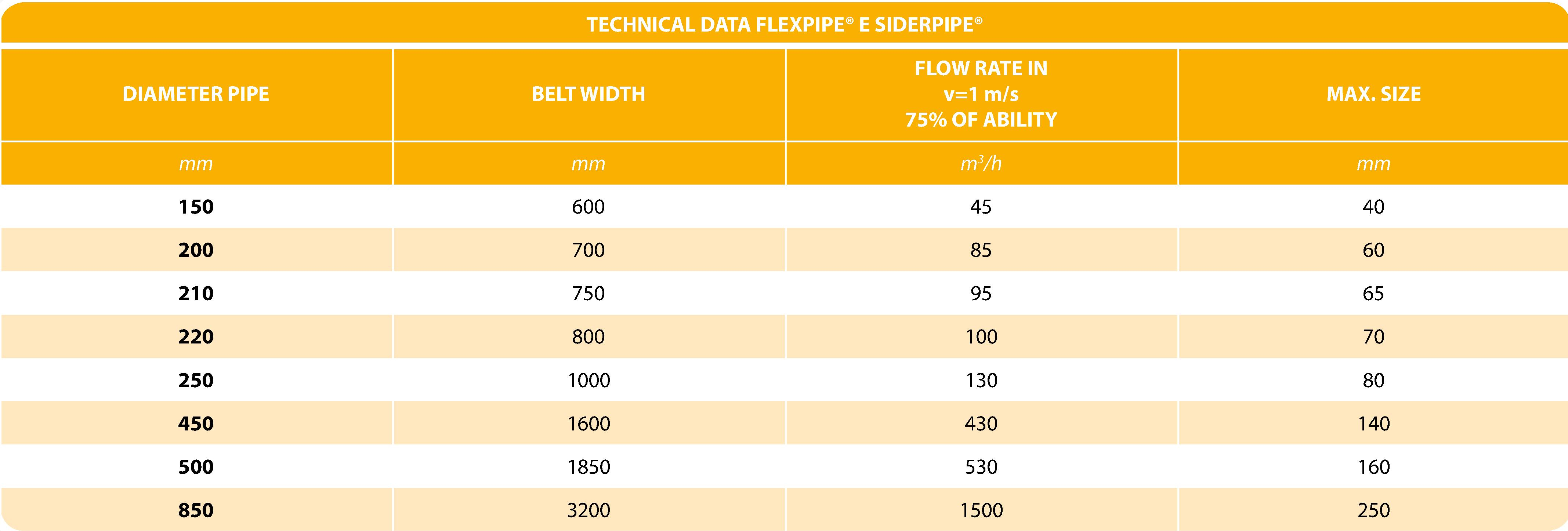 Our tubular belt technology has been developed as a result of greater focus on the environment protection issues, especially in plants bordering parks or residential areas. The carcass, made of multiply synthetic fabric (FLEXPIPE®) or steel cords (SIDERPIPE®), is designed with technical features that ensure the high transverse flexibility being required so that the belt can take the form of a “pipe” in sections where this is an advantage. In other areas where loading and unloading make this more convenient, the belt flattens out to adapt perfectly even to trough conveyors.
Our tubular belt technology has been developed as a result of greater focus on the environment protection issues, especially in plants bordering parks or residential areas. The carcass, made of multiply synthetic fabric (FLEXPIPE®) or steel cords (SIDERPIPE®), is designed with technical features that ensure the high transverse flexibility being required so that the belt can take the form of a “pipe” in sections where this is an advantage. In other areas where loading and unloading make this more convenient, the belt flattens out to adapt perfectly even to trough conveyors.
Passage from flat to tubular shape is created by rollers that are increasingly inclined until they have a hexagonal shape around the “pipe” created by the belt.
In the sections where the belt takes its tubular shape, it allows horizontal and vertical curves with short radius; slope angles of up to 35° can be easily overcome, no conveyed material is dispersed and the material is highly protected against potentially harmful environmental conditions (for example moisture for the cement). We perform specific calculations, based on the quantity and type of material to be conveyed, to determine the type, class and width of the belt to guarantee the necessary carrying capacity.
FLEXPIPE® belts are generally installed in runs that are not too long whereas SIDERPIPE®, thanks to reduced elongation and consequently a reduced need for tensioning units, can run greater distances FLEXPIPE® and SIDERPIPE® belts are produced with molded edges.
Standard covers: W, Y, X, HR – 150, HR – 180, K, OR (see cover table)

 Our tubular belt technology has been developed as a result of greater focus on the environment protection issues, especially in plants bordering parks or residential areas. The carcass, made of multiply synthetic fabric (FLEXPIPE®) or steel cords (SIDERPIPE®), is designed with technical features that ensure the high transverse flexibility being required so that the belt can take the form of a “pipe” in sections where this is an advantage. In other areas where loading and unloading make this more convenient, the belt flattens out to adapt perfectly even to trough conveyors.
Our tubular belt technology has been developed as a result of greater focus on the environment protection issues, especially in plants bordering parks or residential areas. The carcass, made of multiply synthetic fabric (FLEXPIPE®) or steel cords (SIDERPIPE®), is designed with technical features that ensure the high transverse flexibility being required so that the belt can take the form of a “pipe” in sections where this is an advantage. In other areas where loading and unloading make this more convenient, the belt flattens out to adapt perfectly even to trough conveyors.
Passage from flat to tubular shape is created by rollers that are increasingly inclined until they have a hexagonal shape around the “pipe” created by the belt.
In the sections where the belt takes its tubular shape, it allows horizontal and vertical curves with short radius; slope angles of up to 35° can be easily overcome, no conveyed material is dispersed and the material is highly protected against potentially harmful environmental conditions (for example moisture for the cement). We perform specific calculations, based on the quantity and type of material to be conveyed, to determine the type, class and width of the belt to guarantee the necessary carrying capacity.
FLEXPIPE® belts are generally installed in runs that are not too long whereas SIDERPIPE®, thanks to reduced elongation and consequently a reduced need for tensioning units, can run greater distances FLEXPIPE® and SIDERPIPE® belts are produced with molded edges.
Standard covers: W, Y, X, HR – 150, HR – 180, K, OR (see cover table)

 Our tubular belt technology has been developed as a result of greater focus on the environment protection issues, especially in plants bordering parks or residential areas. The carcass, made of multiply synthetic fabric (FLEXPIPE®) or steel cords (SIDERPIPE®), is designed with technical features that ensure the high transverse flexibility being required so that the belt can take the form of a “pipe” in sections where this is an advantage. In other areas where loading and unloading make this more convenient, the belt flattens out to adapt perfectly even to trough conveyors.
Our tubular belt technology has been developed as a result of greater focus on the environment protection issues, especially in plants bordering parks or residential areas. The carcass, made of multiply synthetic fabric (FLEXPIPE®) or steel cords (SIDERPIPE®), is designed with technical features that ensure the high transverse flexibility being required so that the belt can take the form of a “pipe” in sections where this is an advantage. In other areas where loading and unloading make this more convenient, the belt flattens out to adapt perfectly even to trough conveyors.
Passage from flat to tubular shape is created by rollers that are increasingly inclined until they have a hexagonal shape around the “pipe” created by the belt.
In the sections where the belt takes its tubular shape, it allows horizontal and vertical curves with short radius; slope angles of up to 35° can be easily overcome, no conveyed material is dispersed and the material is highly protected against potentially harmful environmental conditions (for example moisture for the cement). We perform specific calculations, based on the quantity and type of material to be conveyed, to determine the type, class and width of the belt to guarantee the necessary carrying capacity.
FLEXPIPE® belts are generally installed in runs that are not too long whereas SIDERPIPE®, thanks to reduced elongation and consequently a reduced need for tensioning units, can run greater distances FLEXPIPE® and SIDERPIPE® belts are produced with molded edges.
Standard covers: W, Y, X, HR – 150, HR – 180, K, OR (see cover table)



